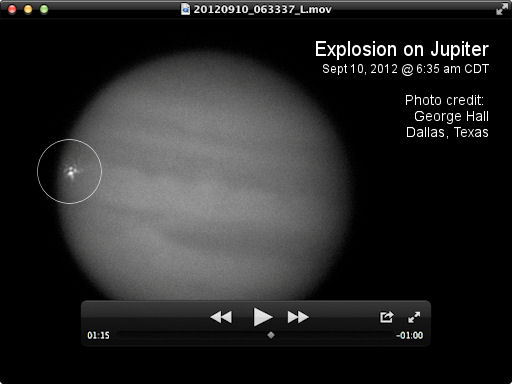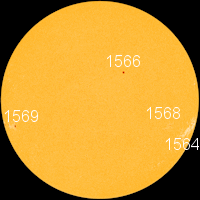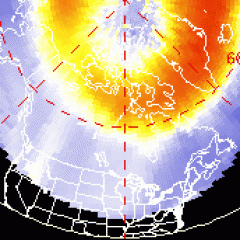DOUBLE ASTEROID FLYBY: A pair of big, near-Earth asteroids will fly by the Earth-Moon system on Sept. 14th. 2012 QG42 is a 300-meter space rock that comes from the inner asteroid belt; it will pass 2.8 million km (7.4 lunar distances) from Earth. 2012 QC8 is even bigger, about 1.1 km in diameter, hailing from the vicinity of Jupiter; it will pass about 8.7 million km (22.7 lunar distances) from Earth. Astronomers monitoring the incoming space rocks say they are glowing like 14th to 15th magnitude stars, which makes them good targets for advanced amateur telescopes. Ephemerides: 2012 QG42, 2012 QC8.
EXPLOSION ON JUPITER: Apparently, something hit Jupiter during the early hours of Sept. 10th (11:35 UT), igniting a ferocious fireball in the giant planet's cloudtops. Amateur astronomer Dan Peterson Racine, Wisconsin, saw it first through his Meade 12" LX200 telescope. "It was a bright white flash that lasted only 1.5 - 2 seconds," he reports. Another amateur astronomer, George Hall of Dallas, Texas, was video-recording Jupiter at the time, and he confirmed the fireball with this video screenshot:

Impact site coordinates: longitude 335o (system 1) and latitude +12o, inside the North Equatorial Belt's southern section.
The fireball was probably caused by a small asteroid or comet hitting Jupiter. Similar impacts were observed in June and August 2010. An analysis of those earlier events suggests that Jupiter is frequently struck by 10 meter-class asteroids--one of the hazards of orbiting near the asteroid belt and having such a strong gravitational pull.
Astronomers around the world will now begin monitoring the impact site for signs of debris--either the cindery remains of the impactor or material dredged up from beneath Jupiter's cloud tops. Some impacts do produce such debris, while others don't. Researchers aren't sure why; perhaps this event will provide some clues. Stay tuned for news about what happens next.
Update: George Hall has posted a complete video of the explosion on Flickr.
![]()
Solar wind
speed: 284.4 km/sec
density: 0.5 protons/cm3
explanation | more data
Updated: Today at 1626 UT
![]()
X-ray Solar Flares
6-hr max: C2 1111 UT Sep11
24-hr: C5 0000 UT Sep11
explanation | more data
Updated: Today at: 1600 UT
![]()
![]()
![]()
Daily Sun: 11 Sep 12
![]()
![]()
Sunspots 1569 and 1564 are crackling with minor C-class solar flares. Credit: SDO/HMI
![]()
![]()
![]()
Sunspot number: 62
What is the sunspot number?
Updated 11 Sep 2012
Spotless Days
Current Stretch: 0 days
2012 total: 0 days (0%)
2011 total: 2 days (<1%)
2010 total: 51 days (14%)
2009 total: 260 days (71%)
Since 2004: 821 days
Typical Solar Min: 486 days
Update 11 Sep 2012
The Radio Sun
10.7 cm flux: 111 sfu
explanation | more data
Updated 11 Sep 2012
![]()
![]()
![]()
Current Auroral Oval:
![]()
Switch to: Europe, USA, New Zealand, Antarctica
Credit: NOAA/POES
![]()
![]()
![]()
Planetary K-index
Now: Kp= 1 quiet
24-hr max: Kp= 1 quiet
explanation | more data
![]()
Interplanetary Mag. Field
Btotal: 3.8 nT
Bz: 2.2 nT south
explanation | more data
Updated: Today at 1626 UT
![]()
![]()
![]()
Coronal Holes: 10 Sep 12
![]()
![]()
There are no large coronal holes on the Earthside of the sun. Credit: SDO/AIA.




